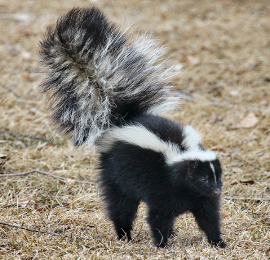 Did you know? Skunks live in all parts of Southern and Central Canada. In fact, the striped skunk, which most of us are familiar with, is native to Canada. And while keeping away from skunks may seem like common sense, it may take a little bit of careful planning depending on your environment. Whether you’ve experienced it or not, one thing is clear: no one wants to deal with a dog that has been skunked.
Did you know? Skunks live in all parts of Southern and Central Canada. In fact, the striped skunk, which most of us are familiar with, is native to Canada. And while keeping away from skunks may seem like common sense, it may take a little bit of careful planning depending on your environment. Whether you’ve experienced it or not, one thing is clear: no one wants to deal with a dog that has been skunked.
When threatened, such as when they have been cornered by a barking dog, skunks spray a foul-smelling liquid as a self-defense mechanism. Most skunks are mild-mannered, however there are factors that go into the skunk’s decision-making process. Knowing where skunks are most commonly found, and learning how to live peacefully with them is an important step to avoiding issues.
Skunks are nocturnal, and not seen often during the day unless disturbed by loud noise or potential predator. Lawnmowers are a big disturbance to small mammals, so take a walk around your lawn before you mow to look for any potential burrows. It is rare for skunks to dig their own dens, but they feel perfectly at home under porches, in cellars and rotting tree stumps, under wood or rock piles, and even in old brush piles.
Be sure to check all of these areas on your property once the snow melts to identify any potential skunk homes. You may think that you would be able to smell a den, however skunks avoid spraying near their home base. If you do find evidence of skunks living on your property, call a professional to remove and relocate them. You never want to attempt to remove a skunk on your own.
Now that you know where and when to find skunks, it is important to plan accordingly when taking your dog out at night. If possible, stick to well-lit areas, especially busier areas with limited foliage. If you live in the country, or usually let your dogs out off-leash, consider leashing at night during the warmer months. Avoid walking country roads at night, as skunks are commonly foraging for roadkill.
In the event of a skunk encounter, try to back away quietly and peacefully. Before a skunk is ready to spray, they will stand on their hind legs with their tail up, and will beat the ground with their front paws. Yelling, running, talking, or using quick movements will result in a one-way trip to stink town, so be as gentle as possible while walking away.
What to do if your dog gets sprayed:
Eliminating skunk odour can be a lot of work, so be patient, thorough, and prepared.
First, keep your dog outside and immediately change into throwaway clothes. Rubber gloves are a good idea, too. It is optimal to bathe your dog outside if the weather permits, however many dogs have to be taken inside. Avoid letting the sprayed area touch anything inside your home. Before the bath, blot the area with paper towels or an old rag to remove as much of the spray as possible. Bathe only the sprayed area first, this will mitigate the smell spreading. Thoroughly wash the area three to five times until the smell releases.
It is ideal to keep a good de-skunking shampoo on hand; you never know when a skunking may happen! However, if you don’t have any skunk treatment on hand, you can neutralize the odour with vinegar. Rub ½ cup of vinegar into the affected area, rinse, and repeat. Next, wash the area thoroughly two to three times with dish soap. Finally, wash with their regular dog shampoo.
Coexisting with skunks is a reality for many people. Learning how to live with them peacefully is our first and best measure of prevention.
Brandon Forder – also known as The Pet Expert – is vice-president of Canadian Pet Connection, a family-owned and -operated business located in Meaford. He has over twenty years’ experience specializing in pet nutrition, behaviour, and healthy pet lifestyles. Canadian Pet Connection is an industry leader committed to providing their clients with the highest levels of personal, attentive service. Learn more at www.CanadianPetConnection.com.











